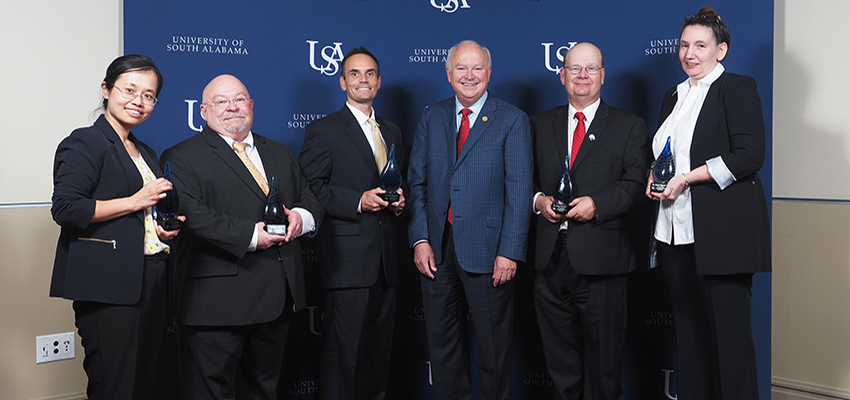Powers and Davis Honored at USA Technology and Research Showcase
Posted on November 20, 2023 by Arts and Sciences

Five University of South Alabama faculty members were honored Oct. 24 at the 2nd Annual Technology and Research Showcase for their research. Dr. Marie Migaud, professor of pharmacology and oncology; Dr. Na Gong, professor of electrical and computer engineering; Dr. Jordan Shropshire, professor of information systems and technology; Dr. Sean Powers, professor of marine and environmental sciences and senior marine scientist at the Dauphin Island Sea Lab; and Dr. James Davis, professor of chemistry; have made advances in artificial intelligence, anti-aging biochemistry, ionic liquids, and protecting our environment and computer systems.
“We are blessed to have faculty here at South who are very interested in research and who have brought millions of dollars in research funding to South,” said Dr. Michael Chambers, associate vice president for research at USA. “Our external funding has doubled since 2018. This does not happen without faculty taking the time to file grant requests to compete for funding from various sources.”
Attending the event were local and state leaders, including Innovate Alabama CEO Cynthia Crutchfield and Alabama Finance Director Bill Poole.
“What an incredible asset USA is to the state of Alabama. I don’t think people realize what a powerhouse this University is,” Poole said. “Research in higher education is one of the most important things we can dedicate ourselves to. It’s the key to solving our problems.”
This year’s College of Arts and Sciences honorees and a summary of their research:
Dr. Sean Powers, director of the Stokes School of Marine and Environmental Sciences, professor of marine sciences, and senior marine scientist at the Dauphin Island Sea Lab
Alabama’s waterways house some of the most biodiverse ecosystems in the U.S., and they are a major source of state revenue. It is estimated that Alabama’s water-based recreation industry brings in over $1 billion a year for Alabama. Mobile is uniquely located on Mobile Bay at the foot of the Mobile-Tensaw Delta. Preserving this natural treasure and the marine life it sustains has long been recognized as a priority for the state. But how do we measure marine diversity and ecosystem sustainability when so much of it lies below the water? Powers and his research team have the answer. His research focuses on marine fish and invertebrates and their habitats to help direct conservation and restoration efforts of Alabama’s recreational and commercial fisheries. University of South Alabama researchers have pioneered the use of advanced technologies to help make direct observations of fish and invertebrates in their marine habitats. Underwater cameras, remotely operated vehicles, satellite tracking of fish, seafloor mapping and artificial intelligence are cost-effective methods used by Dr. Powers and his team to monitor marine life. Direct observation of Alabama’s marine life provides an accurate census of fish populations, which can help identify areas in need of conservation and restoration. Using these methods, he has published over 150 peer-reviewed scientific articles and has been awarded over $46 million in grant funding for his work. And the conservation work of Dr. Powers doesn’t stop at research and data collection. He currently serves on the Board of Trustees for Alabama’s Forever Wild Land Trust Board. He advises several Gulf States, including Alabama, on fisheries management and conservation activities. And his work has been featured on the Discovery Channel, National Geographic, PBS, CNN and local media. As advocates for Alabama’s clean waters and marine habitats, Powers and his research team provide the critical information to help build sustainable solutions to maintain Alabama’s marine life.
Dr. James Davis, professor of chemistry
One leading concern of this century is the long-term global impact of excess carbon dioxide on the air and water quality, weather patterns and delicate ecosystems of our planet. Industrialization and innovation have increased the quality of our lives, but they have been fueled by the combustion of fossil fuels, leading to a build-up of carbon dioxide in our atmosphere at a faster rate than ever. Industrial scale production of carbon dioxide requires an industrial scale solution that avoids further air or groundwater pollution. Researchers at the University of South Alabama, led by Davis, have created ionic liquids capable of removing carbon dioxide from the air through direct air capture. Ionic liquids are salts that are liquids at the temperature they are used, and ionic liquids have a variety of uses in environmentally benign processes. Using ionic liquids, carbon dioxide is selectively sequestered, or captured, from the air by passing through a scrubbing chamber, thereby reducing carbon dioxide levels while leaving no air pollutants and no volatile chemicals. Davis and his research collaborators at the South Alabama Ionic Liquids Laboratory, or SAILL, have pioneered the use of ionic liquids to reduce carbon dioxide from industrial exhaust. And while this application can greatly impact our future carbon dioxide output, the uses of ionic liquids do not end with carbon dioxide capture from the air. Davis and SAILL have investigated this versatile family of compounds for use in battery development, military technologies, and medical treatment. To date, Davis has received over $6 million in research funding to advance the application of ionic liquids, and innovations by SAILL have accelerated due to growing commercial interest. The market for ionic liquids is projected to grow to approximately $4.5 billion by 2027. Collaborations with the U.S. Navy and engineering firms have transformed the foundational research by Davis into real-world solutions to many of the industrial-sized problems we face today. Innovation in ionic liquids taps into our greater potential for a better, cleaner tomorrow.


